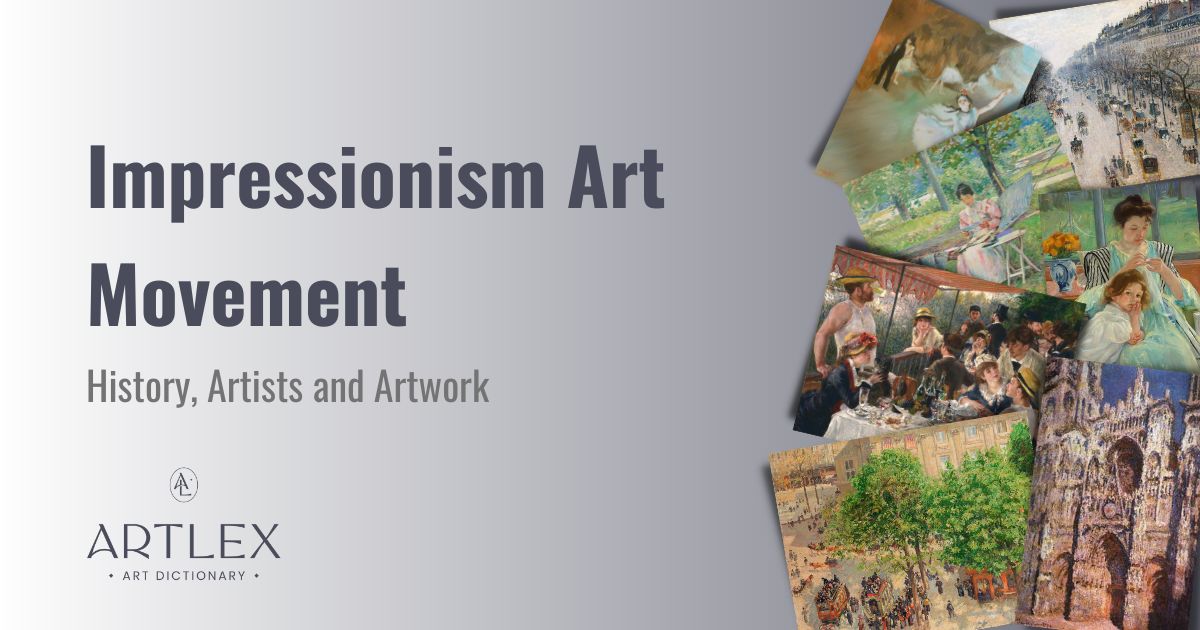What is Impressionism?
Impressionism is an art movement that originated in France in the 1860s and lasted until the late 1880s. The movement introduced new approaches to painting, such as capturing the changing effects of daylight on colors and objects at different times of the day, painting outdoors, and painting scenes from everyday life. The impressionist painting style is characterized by a bright color palette, thick paint, and quick brush strokes. The leaders of the movement were: Claude Monet (1840-1926), Camille Pissarro (1830-1903), Alfred Sisley (1839-1899), Pierre-Auguste Renoir (1841-1919), Berthe Morisot (1841-1895), and Edgar Degas (1834-1917).
Notable Impressionist Artworks
- Claude Monet, Impression, Sunrise, 1872, Musée Marmottan Monet, Paris, France
- Claude Monet, The Gare Saint-Lazare, 1877, Musée d’Orsay, Paris, France
- Claude Monet, Rouen Cathedral, 1893, Musée d’Orsay, Paris, France
- Pierre-Auguste Renoir, Luncheon of the Boating Party, 1881, The Phillips Collection, Washington D.C., USA
- Camille Pissarro, Place du Theatre-Français, Spring, 1898, The State Hermitage Museum, Saint Petersburg, Russia
- Camille Pissarro,The Boulevard Montmartre on a Winter Morning, 1897, The Metropolitan Museum of Art, New York City, New York, USA
- Berthe Morisot, Hanging the Laundry out to Dry, 1875, National Gallery of Art, Washington D.C., USA
- Edgar Degas, Ballet – l’étoile, 1878, Musée d’Orsay, Paris, France
- Mary Cassatt, Woman Sitting with a Child in Her Arms, 1890, The Bilbao Fine Art Museum, Bilbao, Spain
- Mary Cassat, Young Mother Sewing, 1900, The Metropolitan Museum of Art, New York City, New York, USA
- Theodore Robinson, Correspondence, 1895, private collection
- Childe Hassam, In the Garden (Celia Thaxter in Her Garden), 1892, Smithsonian American Art Museum, Washington D.C., USA
The Origins of Impressionism
Impressionism was born as a reaction to the official art of the French Academy of Fine Arts and the government-sponsored annual exhibitions called Salons. In the 19th century, this “approved” art was associated with Neoclassicism and, to a lesser extent, Romanticism and Symbolism. Academic standards in painting implied working in a studio after making many preparatory drawings and a particular way of applying paint to the canvas (smooth, almost invisible brush strokes). The Academy favored an idealized grand scene, mostly showing an event from mythology or history and containing intellectual, virtuous, and sometimes political messages.
By mid 19th century, however, a group of artists sharing an interest in painting landscapes and scenes from everyday life rather than historical or mythological subjects emerged. The group brought together names such as Claude Monet, Pierre-Auguste Renoir, Camille Pissarro, Alfred Sisley, Frédéric Bazille, and Paul Cézanne. Instead of working in studios, they painted outdoors, capturing actual scenes from real life. After their works were rejected by the Salon’s jury in 1863, the artists mentioned above have arranged their first independent art show in Paris that started Impressionism. Monet’s painting called Impression: Sunrise (1872), exhibited on this occasion, gave its name to the movement. The impressionists held seven more exhibitions until 1886. By that time, their bold art was widely popular.
Characteristics of Impressionism
Interested in capturing the ephemeral nature of light and the changes it makes during the day, the Impressionists left the studio and went outdoors to paint in the open air (“en plein air“). The appearance of oil paints available in tubes enabled this change in the approach to painting to occur. The Impressionist painters worked quickly “on the spot” using short, highly visible brush strokes and not paying attention to detail. While trying to capture a particular moment in time and the appearance of objects under different lighting, Impressionist painters painted the essence of the scene rather than the subject’s details.
They often mixed colors directly on the canvas and used pure and brighter color tones. Impressionists also changed the display of shadows. The science of color and especially Michel Eugène Chevreul’s theory of complementary colors greatly influenced the work of Impressionists in creating new color harmonies and rendering shadows in colors. Black and gray tones could no longer be found in the Impressionist paintings.
As for subjects, they did not paint from literature, history, or mythology, but rather ordinary subjects from everyday life both in the French countryside and in Paris. Many Impressionist painters, particularly Claude Monet, would paint the same subject multiple times at different times of day or year, such as his series of Rouen Cathedral and Gare Saint-Lazare paintings.
Legacy of Impressionism
With their revolutionary way of looking at and depicting the world, the Impressionists forever broke with the tradition of fine arts in 19th century France, paving the way for the development of modern art. By 1886, many artists worldwide adopted the Impressionist style, especially in Great Britain and the United States. Those artists who were directly influenced by the impressionist movement in France were Paul Gauguin, Vincent van Gogh, and Georges Seurat, who became known as Post-Impressionists. They will then push the boundaries of the style in new directions laying the foundations of Divisionism, Fauvism, Cubism, and Expressionism. Impressionism also found expression in art forms other than the visual arts, such as literature (Octave Mirbeau) and music (Claude Debussy).
List of Notable Impressionist Artists
- Claude Monet (1840-1926), French
- Camille Pissarro (1830-1903), French
- Pierre-Auguste Renoir (1841-1919), French
- Berthe Morisot (1841-1895), French
- Armand Guillaumin (1841-1927), French
- Alfred Sisley (1839-1899), French-British
- Edgar Degas (1834-1917), French
- Frédéric Bazille (1841-1870), French
- Mary Cassatt (1844-1926), American
- Theodore Robinson (1852-1896), American
- Childe Hassam (1859-1935), American
- Philip Wilson Steer (1860-1942), British
Related Art Terms
- Post-Impressionism
- Neo-Impressionism
- Pointillism
- Divisionism
- Landscape Painting
- Plein Air Painting

